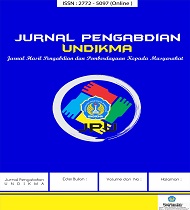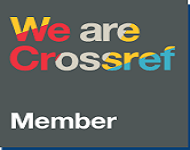Didactic Transposition in Reading Material : Linking Knowledge to be Taught and Assessment for Learning
DOI:
https://doi.org/10.33394/jk.v11i2.15375Keywords:
Arabic Language, Curriculum, Didactics, Reading, Textbook, Transposition.Abstract
This study aims to elaborate on the assessment of instructional planning (lesson plan), particularly how planning emerges from the teacher's internal didactic transposition. It focuses on the diffusion of knowledge by teachers from the curriculum and textbooks into the form of teaching modules or lesson plans. A qualitative approach through phenomenological research method was employed in this study. The data sources include the Arabic language teaching module for Grade 3 Madrasah Ibtidaiyah in Bandung and Arabic language teacher as participants. The selection of one Arabic teacher as a participant in this study can be justified methodologically with a purposive sampling approach. Data collection techniques consisted of document analysis and in-depth interviews, followed by a praxeological review as an analytical tool. The assessment results identified learning barriers faced by students in the Qiraah (reading) skill material. In this context, internal didactic transposition defined as the transformation of theoretical material into teaching practice plays a crucial role in aligning instructional content with students’ needs and learning objectives. The process of internal transposition in Qiraah instruction positively impacts students’ reading skills, especially when teaching materials are adapted contextually and made relevant to the students’ proficiency levels. These findings pave the way for deeper investigation into the influence of teacher-student verbal exchanges and teaching approaches on students’ comprehension of vocabulary and their reading strategies in Arabic text-based instruction.
References
Al Farisi, M. Z., Maulani, H., Hardoyo, A. B., Khalid, S. M., & Saleh, N. (2024). Investigating Arabic language teaching materials based on Indonesian folklore: an ethnographic study on the folktale of “Bandung.†Asian Education and Development Studies, 13(2), 134–149. https://doi.org/10.1108/AEDS-07-2023-0082
Allail, C. A., Sopian, A., Saleh, N., Maulani, H., & Indonesia, U. P. (2025). Praxeology Analysis of The Arabic Language Textbook for Madrasah Ibtidaiyah. 2(2). https://doi.org/10.32332/ijalt.v7i01.10066
Asse, A., Jabir, M., Idhan, M., & Harun, U. (1894). Al-Intiqaiyyah Method to Improve Maharah Al-Qira ’ ah Skills in Arabic Language Learning.
Bestandani, I. (2024). Irene Bestandani 1) , Syamsurrijal 2). 3(2), 229–238.
Cesaria, A., & Herman, T. (2019). Learning obstacle in geometry. Journal of Engineering Science and Technology, 14(3), 1271–1280.
Chevallard, Y. (1989). On didatic transposition theory: some introductory notes. Lnternational Symposium on Selected Domains of Research and Development in Mathematics Education, 1–9. http://yves.chevallard.free.fr/spip/spip/article.php3?id_article=122
de Oliveira, A. P., & Barbosa, N. D. (2023). Tasks About Impossible Random Events: A Pedagogical Game as a Teaching Tool for the Early Years of Elementary School. Acta Scientiae, 25(6), 183–208. https://doi.org/10.17648/acta.scientiae.7654
Filipović, J. (2019). Transdisciplinary qualitative paradigm in applied linguistics: autoethnography, participatory action research and minority language teaching and learning *. International Journal of Qualitative Studies in Education, 32(5), 493–509. https://doi.org/10.1080/09518398.2019.1597209
Fitrianto, I. (2024). Innovation and Technology in Arabic Language Learning in Indonesia : Trends and Implications. 2(3), 134–150.
Ghani, S. A., Ahmad, S. Z. @ H., Hashim, U. H. H., Shaadon, Z., & Mustapa, N. S. (2012). Application of basic Skills in Reading Arabic Text for Teaching and Learning Maharat Al-Qiraah. Procedia - Social and Behavioral Sciences, 59, 26–32. https://doi.org/10.1016/j.sbspro.2012.09.241
HastiYunianta, T. N., Suryadi, D., Dasari, D., & Herman, T. (2023). Textbook praxeological-didactical analysis: Lessons learned from the Indonesian mathematics textbook. Journal on Mathematics Education, 14(3), 503–524. https://doi.org/10.22342/jme.v14i3.pp503-524
Hendriyanto, A., Suryadi, D., Dahlan, J. A., & Juandi, D. (2023). Praxeology review: Comparing Singaporean and Indonesian textbooks in introducing the concept of sets. Eurasia Journal of Mathematics, Science and Technology Education, 19(2), 1–13. https://doi.org/10.29333/ejmste/12953
Herizal, H., & Priatna, N. (2024). The Concept of Angles Formed by a Transversal: A Study of Undergraduate Students’ Learned Knowledge in the Didactic Transposition Process. Proceedings of Malikussaleh International Conference On Education Social Humanities And Innovation (Miceshi), 1(1), 57.
Huda, M. N., Nurrosyid, A. F., & Aji, A. B. (2021). Implementasi Metode Qira’ah dalam Pembelajaran Bahasa Arab di Madrasah Hidayatul Mubtadiin Lirboyo Kediri. Alfakkaar: Jurnal Pendidikan Bahasa Arab, 5(2), 79–93.
Jamilah, J., Suryadi, D., & Priatna, N. (2020). Didactic transposition from scholarly knowledge of mathematics to school mathematics on sets theory. Journal of Physics: Conference Series, 1521(3). https://doi.org/10.1088/1742-6596/1521/3/032093
Jubhari, Y., Sasabone, L., & Nurliah, N. (2022). The Effectiveness of Contextual Teaching and Learning Approach in Enhancing Indonesian EFL Secondary Learners’ Narrative Writing Skill. REiLA : Journal of Research and Innovation in Language, 4(1), 54–66. https://doi.org/10.31849/reila.v4i1.8633
Junaeti, E., Juandi, D., Rahman, E. F., & Suba, J. M. (2023). From Scholarly Knowledge to Knowledge to be Taught: The Case of Vector Introduction. Journal of Didactic Studies, 1(1), 1–10.
Khan, S. N. (2014). Qualitative research method - Phenomenology. Asian Social Science, 10(21), 298–310. https://doi.org/10.5539/ass.v10n21p298
Le, H., Janssen, J., & Wubbels, T. (2018). Collaborative learning practices: teacher and student perceived obstacles to effective student collaboration. Cambridge Journal of Education, 48(1), 103–122. https://doi.org/10.1080/0305764X.2016.1259389
Lee, H., & Lee, J. H. (2015). The Effects of Electronic Glossing Types on Foreign Language Vocabulary Learning: Different Types of Format and Glossary Information. Asia-Pacific Education Researcher, 24(4), 591–601. https://doi.org/10.1007/s40299-014-0204-3
Martini, B., Michelini, M., Stefanel, A., & Tombolato, M. (2021). Prospective teachers’ representations on the concept of force. Education Sciences, 11(10), 1–26. https://doi.org/10.3390/educsci11100614
Maryani, I., Martaningsih, S. T., & Putra Bhakti, C. (2017). Module Based on Pedagogical Content Knowledge to Increase the Engagement and Skills of the Future Teachers in Designing a Lesson Plan. Journal of Education and Learning (EduLearn), 11(1), 91–102. https://doi.org/10.11591/edulearn.v11i1.5758
Mumm, K., Karm, M., & Remmik, M. (2016). Assessment for learning: Why assessment does not always support student teachers’ learning. Journal of Further and Higher Education, 40(6), 780–803. https://doi.org/10.1080/0309877X.2015.1062847
Nicolás, P., & Gascón, J. (2024). Limits and transforming power of didactics To cite this version : HAL Id : hal-04421179 Limits and transforming power of didactics.
Pauji, I., Suryadi, D., Bin, M. A., Setambah, B., & Hendriyanto, A. (2023). Indonesian Journal of Science and Mathematics Education XX (X) (20XX) X-X mm 20XX Learning Obstacle In The Introduction To Number: A Critical Study Within Didactical Design Research Framework. X. https://doi.org/10.24042/ijsme.v5i1.19792
Rohma, F., & Fawaid, A. (2023). Analysis of Students’ Difficulties In Reading Texts to Increase Reading Comprehension In Islamic Senior High School. Al Qalam: Jurnal Ilmiah Keagamaan Dan Kemasyarakatan, 17(3), 2003. https://doi.org/10.35931/aq.v17i3.2205
Roth, A. W., Lawless, D., Tobin, K., & Roth, W. (2017). Towards a Praxeology of Teaching Published by : Canadian Society for the Study of Education Stable URL : http://www.jstor.org/stable/1585864 Towards a Praxeology of Teaching. 25(1), 1–15.
Schellekens, L. H., Bok, H. G. J., de Jong, L. H., van der Schaaf, M. F., Kremer, W. D. J., & van der Vleuten, C. P. M. (2021). A scoping review on the notions of Assessment as Learning (AaL), Assessment for Learning (AfL), and Assessment of Learning (AoL). Studies in Educational Evaluation, 71(July), 101094. https://doi.org/10.1016/j.stueduc.2021.101094
Strømskag, H., & Chevallard , Y. (2024). Didactic transposition and the knowledge to be taught: towards an archeorganisation for concave/convex functions. International Journal of Mathematical Education in Science and Technology. https://doi.org/10.1080/0020739X.2024.2305879
Syihabuddin, S., Murtadho, N., Baso, Y. S., Maulani, H., & Khalid, S. M. (2024). The acquisition of nominal gender agreement: praxeology analysis of Arabic second language text book “Silsilah Al-Lisaan.†Journal of Applied Research in Higher Education, 16(4), 1055–1068. https://doi.org/10.1108/JARHE-11-2022-0369
Taber, K. S. (2018). Scaffolding learning: Principles for effective teaching and the design of classroom resources. Effective Teaching and Learning: Perspectives, Strategies and Implementation, September 2018, 1–44.
Taras, M. (2010). Assessment for learning: Assessing the theory and evidence. Procedia - Social and Behavioral Sciences, 2(2), 3015–3022. https://doi.org/10.1016/j.sbspro.2010.03.457
Totohasina, A., Masonova, B., & Bemena, S. (2024). Philosophical conception of the answers to the question “ Can one become a good teacher ?†803–826.
Weir, C. J. (2005). Limitations of the Common European Framework for developing comparable examinations and tests. Language Testing, 22(3), 281–300. https://doi.org/10.1191/0265532205lt309oa
Wijayanti, D., & Aufa, D. N. (2020). Picturing Textbook on Exponent Equations Based on Praxeology Organization. 409(SoRes 2019), 494–498. https://doi.org/10.2991/assehr.k.200225.107
Wilson, J., & Hernández, T. (2021). Research Article Intellectual Challenges For Improving Esl Students ’ Performance During Pandemic. 02(11), 3184–3191.
Yang, P.-L., & Wang, A.-L. (2015). Investigating the Relationship Among Language Learning Strategies, English Self-Efficacy, and Explicit Strategy Instructions. Taiwan Journal of TESOL, 121, 35–62. http://files.eric.ed.gov/fulltext/EJ1078937.pdf
Downloads
Additional Files
Published
How to Cite
Issue
Section
Citation Check
License
License and Publishing Agreement
In submitting the manuscript to the journal, the authors certify that:
- They are authorized by their co-authors to enter into these arrangements.
- The work described has not been formally published before, except in the form of an abstract or as part of a published lecture, review, thesis, or overlay journal.
- That it is not under consideration for publication elsewhere,
- That its publication has been approved by all the author(s) and by the responsible authorities tacitly or explicitly of the institutes where the work has been carried out.
- They secure the right to reproduce any material that has already been published or copyrighted elsewhere.
- They agree to the following license and publishing agreement.
Copyright
Authors who publish with JK agree to the following terms:
- Authors retain copyright and grant the journal right of first publication with the work simultaneously licensed under a Creative Commons Attribution License (CC BY-SA 4.0) that allows others to share the work with an acknowledgment of the work's authorship and initial publication in this journal.
- Authors are able to enter into separate, additional contractual arrangements for the non-exclusive distribution of the journal's published version of the work (e.g., post it to an institutional repository or publish it in a book), with an acknowledgment of its initial publication in this journal.
- Authors are permitted and encouraged to post their work online (e.g., in institutional repositories or on their website) prior to and during the submission process, as it can lead to productive exchanges, as well as earlier and greater citation of published work.
Licensing for Data Publication
-
Open Data Commons Attribution License, http://www.opendatacommons.org/licenses/by/1.0/ (default)

This work is licensed under a Creative Commons Attribution-ShareAlike 4.0 International License.







